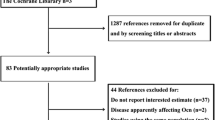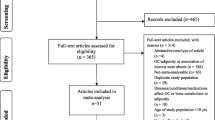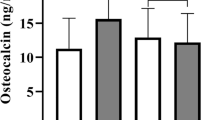Abstract
Serum total osteocalcin, a marker of bone formation, may regulate glucose metabolism and influence the risk of developing adverse metabolic outcomes. We conducted a systematic review and meta-analysis of published observational evidence, to assess and quantify the associations of serum total osteocalcin with type 2 diabetes and intermediate metabolic phenotypes [e.g., metabolic syndrome (MetS)]. Relevant studies were identified in a literature search of MEDLINE, EMBASE, Web of Science, and reference lists of relevant studies to May 2015. Mean differences and risk estimates (odds ratios or relative risks) with 95 % CIs were aggregated using random-effects models. Fifty-two observational (38 cross-sectional, eight cohort, five case–control, and one both cross-sectional and cohort) studies with data on 46,998 non-overlapping participants were included. Baseline serum total osteocalcin levels were significantly lower in type 2 diabetes compared with non-type 2 diabetes and in MetS compared with non-MetS in pooled analysis of cross-sectional evidence. Pooled risk estimates (95 % CIs) for type 2 diabetes in a comparison of extreme fourths of total osteocalcin levels were 0.23 (95 % CI 0.12, 0.46) and 0.89 (95 % CI 0.78, 1.01) for cross-sectional and cohort studies respectively. The corresponding estimate was 0.39 (0.27, 0.56) for MetS from cross-sectional evidence. In both cross-sectional and cohort studies, a unit increase in serum total osteocalcin levels was associated with a significant mean increase in HOMA-B and mean reduction in HbA1c; with significant mean reductions in fasting plasma glucose levels, HOMA-IR, and body mass index in only cross-sectional studies. Available evidence—mainly from cross-sectional studies, supports inverse associations of serum total osteocalcin with risk of adverse metabolic outcomes. Large-scale prospective studies are needed to establish whether serum total osteocalcin may be useful in the prevention of adverse metabolic outcomes such as type 2 diabetes.




Similar content being viewed by others
References
Price PA. Gla-containing proteins of bone. Connect Tissue Res. 1989;21(1–4):51–7; discussion 7–60.
Gerdhem P, Isaksson A, Akesson K, Obrant KJ. Increased bone density and decreased bone turnover, but no evident alteration of fracture susceptibility in elderly women with diabetes mellitus. Osteoporos Int. 2005;16(12):1506–12. doi:10.1007/s00198-005-1877-5.
Lee NK, Sowa H, Hinoi E, et al. Endocrine regulation of energy metabolism by the skeleton. Cell. 2007;130(3):456–69. doi:10.1016/j.cell.2007.05.047.
Hauschka PV, Lian JB, Cole DE, Gundberg CM. Osteocalcin and matrix Gla protein: vitamin K-dependent proteins in bone. Physiol Rev. 1989;69(3):990–1047.
Ferron M, McKee MD, Levine RL, Ducy P, Karsenty G. Intermittent injections of osteocalcin improve glucose metabolism and prevent type 2 diabetes in mice. Bone. 2012;50(2):568–75. doi:10.1016/j.bone.2011.04.017.
Lerchbaum E, Schwetz V, Nauck M, Volzke H, Wallaschofski H, Hannemann A. Lower bone turnover markers in metabolic syndrome and diabetes: the population-based Study of Health in Pomerania. Nutr Metab Cardiovasc Dis. 2015;. doi:10.1016/j.numecd.2015.02.002.
Yeap BB, Alfonso H, Chubb SA, et al. Higher serum undercarboxylated osteocalcin and other bone turnover markers are associated with reduced diabetes risk and lower estradiol concentrations in older men. J Clin Endocrinol Metab. 2015;100(1):63–71. doi:10.1210/jc.2014-3019.
Yeap BB, Chubb SA, Flicker L, et al. Reduced serum total osteocalcin is associated with metabolic syndrome in older men via waist circumference, hyperglycemia, and triglyceride levels. Eur J Endocrinol. 2010;163(2):265–72. doi:10.1530/EJE-10-0414.
Liatis S, Sfikakis PP, Tsiakou A, et al. Baseline osteocalcin levels and incident diabetes in a 3-year prospective study of high-risk individuals. Diabetes Metab. 2014;40(3):198–203. doi:10.1016/j.diabet.2014.01.001.
Movahed A, Larijani B, Nabipour I, et al. Reduced serum osteocalcin concentrations are associated with type 2 diabetes mellitus and the metabolic syndrome components in postmenopausal women: the crosstalk between bone and energy metabolism. J Bone Miner Metab. 2012;30(6):683–91. doi:10.1007/s00774-012-0367-z.
Stroup DF, Berlin JA, Morton SC, et al. Meta-analysis of observational studies in epidemiology. J Am Med Assoc. 2000;283(15):2008–12. doi:10.1001/jama.283.15.2008.
Moher D, Liberati A, Tetzlaff J, Altman DG. Preferred reporting items for systematic reviews and meta-analyses: the PRISMA statement. PloS Med. 2009;6(7):e1000097. doi:10.1371/journal.pmed.1000097.
Wells GA, Shea B, O’Connell D, et al. The Newcastle–Ottawa Scale (NOS) for assessing the quality of nonrandomised studies in meta-analyses. 2011. www.ohri.ca/programs/clinical_epidemiology/oxford.asp. http://www.ohri.ca/programs/clinical_epidemiology/oxford.asp (Accessed 10 Mar 2015).
van Dijk GM, Maneva M, Colpani V, et al. The association between vasomotor symptoms and metabolic health in peri- and post-menopausal women: a systematic review. Maturitas. 2015;80(2):140–7. doi:10.1016/j.maturitas.2014.11.016.
Hozo SP, Djulbegovic B, Hozo I. Estimating the mean and variance from the median, range, and the size of a sample. BMC Med Res Methodol. 2005;5:13. doi:10.1186/1471-2288-5-13.
Chêne G, Thompson SG. Methods for summarizing the risk associations of quantitative variables in epidemiologic studies in a consistent form. Am J Epidemiol. 1996;144(6):610–21.
Greenland S, Longnecker MP. Methods for trend estimation from summarized dose-response data, with applications to meta-analysis. Am J Epidemiol. 1992;135(11):1301–9.
DerSimonian R, Laird N. Meta-analysis in clinical trials. Control Clin Trials. 1986;7(3):177–88. doi:10.1016/0197-2456(86)90046-2.
Higgins JP, Thompson SG, Deeks JJ, Altman DG. Measuring inconsistency in meta-analyses. BMJ. 2003;327(7414):557–60. doi:10.1136/bmj.327.7414.557.
Egger M, Davey Smith G, Schneider M, Minder C. Bias in meta-analysis detected by a simple, graphical test. BMJ. 1997;315(7109):629–34.
Garnero P, Grimaux M, Demiaux B, Preaudat C, Seguin P, Delmas PD. Measurement of serum osteocalcin with a human-specific two-site immunoradiometric assay. J Bone Miner Res. 1992;7(12):1389–98. doi:10.1002/jbmr.5650071206.
Szulc P, Varennes A, Delmas PD, Goudable J, Chapurlat R. Men with metabolic syndrome have lower bone mineral density but lower fracture risk—the MINOS study. J Bone Miner Res. 2010;25(6):1446–54. doi:10.1002/jbmr.13.
Kanazawa I, Yamaguchi T, Tada Y, Yamauchi M, Yano S, Sugimoto T. Serum osteocalcin level is positively associated with insulin sensitivity and secretion in patients with type 2 diabetes. Bone. 2011;48(4):720–5. doi:10.1016/j.bone.2010.12.020.
Confavreux CB, Levine RL, Karsenty G. A paradigm of integrative physiology, the crosstalk between bone and energy metabolisms. Mol Cell Endocrinol. 2009;310(1–2):21–9. doi:10.1016/j.mce.2009.04.004.
Hinoi E, Gao N, Jung DY, et al. The sympathetic tone mediates leptin’s inhibition of insulin secretion by modulating osteocalcin bioactivity. J Cell Biol. 2008;183(7):1235–42. doi:10.1083/jcb.200809113.
Ducy P. The role of osteocalcin in the endocrine cross-talk between bone remodelling and energy metabolism. Diabetologia. 2011;54(6):1291–7. doi:10.1007/s00125-011-2155-z.
Wei J, Karsenty G. An overview of the metabolic functions of osteocalcin. Curr Osteoporos Rep. 2015;. doi:10.1007/s11914-015-0267-y.
Lee NK, Karsenty G. Reciprocal regulation of bone and energy metabolism. Trends Endocrinol Metab. 2008;19(5):161–6. doi:10.1016/j.tem.2008.02.006.
Hwang YC, Jeong IK, Ahn KJ, Chung HY. The uncarboxylated form of osteocalcin is associated with improved glucose tolerance and enhanced beta-cell function in middle-aged male subjects. Diabetes Metab Res Rev. 2009;25(8):768–72. doi:10.1002/dmrr.1045.
Shea MK, Gundberg CM, Meigs JB, et al. Gamma-carboxylation of osteocalcin and insulin resistance in older men and women. Am J Clin Nutr. 2009;90(5):1230–5. doi:10.3945/ajcn.2009.28151.
Kanazawa I, Yamaguchi T, Yamauchi M, et al. Adiponectin is associated with changes in bone markers during glycemic control in type 2 diabetes mellitus. J Clin Endocrinol Metab. 2009;94(8):3031–7. doi:10.1210/jc.2008-2187.
Kanazawa I, Yamaguchi T, Yamauchi M, et al. Serum undercarboxylated osteocalcin was inversely associated with plasma glucose level and fat mass in type 2 diabetes mellitus. Osteoporos Int. 2011;22(1):187–94. doi:10.1007/s00198-010-1184-7.
Takahashi M, Kushida K, Nagano A, Inoue T. Comparison of the analytical and clinical performance characteristics of an N-MID versus an intact osteocalcin immunoradiometric assay. Clin Chim Acta. 2000;294(1–2):67–76.
Gundberg CM, Nieman SD, Abrams S, Rosen H. Vitamin K status and bone health: an analysis of methods for determination of undercarboxylated osteocalcin. J Clin Endocrinol Metab. 1998;83(9):3258–66. doi:10.1210/jcem.83.9.5126.
Higgins JPT, Green S, editors. Cochrane handbook for systematic reviews of interventions version 5.1.0 (updated March 2011). The Cochrane Collaboration; 2011. www.cochrane-handbook.org (Accessed 01 Mar 2013).
Acknowledgments
We thank Anil Baran Choudhury, PhD, Government Medical college Rajnandgaon, India; Rebeca Reyes, MD, PhD, Bone Metabolic Unit (RETICEF), Endocrinology Division, Hospital Universitario San Cecilio, Av. Dr. Oloriz 16, 18012 Granada, Spain; Weiping Jia, Department of Endocrinology and Metabolism, Shanghai Diabetes Institute, Shanghai Key Laboratory of Diabetes Mellitus, Shanghai Clinical Center for Diabetes, Shanghai Jiao Tong University Affiliated Sixth People’s Hospital, Shangai, China; Dong Hyun Sinn, Department of Medicine, Samsung Medical Center, Sungkyunkwan University School of Medicine, Seoul, Korea; and Zhen-lin Zhang, Metabolic Bone Disease and Genetic Research Unit, Department of Osteoporosis and Bone Diseases, Shanghai Jiao Tong University Affiliated Sixth People’s Hospital, Shanghai, China for readily providing data on request.
Conflict of interest
None.
Author information
Authors and Affiliations
Corresponding author
Electronic supplementary material
Below is the link to the electronic supplementary material.
Rights and permissions
About this article
Cite this article
Kunutsor, S.K., Apekey, T.A. & Laukkanen, J.A. Association of serum total osteocalcin with type 2 diabetes and intermediate metabolic phenotypes: systematic review and meta-analysis of observational evidence. Eur J Epidemiol 30, 599–614 (2015). https://doi.org/10.1007/s10654-015-0058-x
Received:
Accepted:
Published:
Issue Date:
DOI: https://doi.org/10.1007/s10654-015-0058-x




